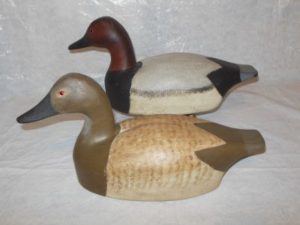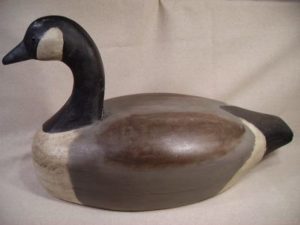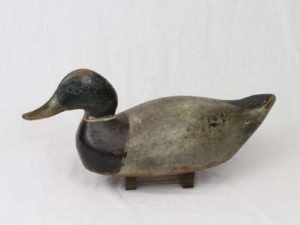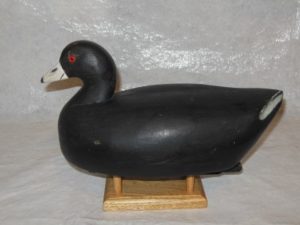A Decoy Corner Article
By Bruce Urben, President
All images courtesy Wisconsin Sporting Collectibles
 Lester Beattie was born in 1912 and was raised on a small farm west of Neenah, WI. Les was a sportsman his entire life, hunting, trapping and fishing to put food on the table for his family. He moved to the VanDyne area in Fond du Lac county later in life.
Lester Beattie was born in 1912 and was raised on a small farm west of Neenah, WI. Les was a sportsman his entire life, hunting, trapping and fishing to put food on the table for his family. He moved to the VanDyne area in Fond du Lac county later in life.
At the age of 13, like many carvers from the early 1900’s, Lester started making decoys for his own use. His carving mentor was Bud Haber (1905-1977), a carpenter from Menasha, WI. Bud had a great influence on Lester’s carving as a schoolboy in the 1920’s.
 In early 1930, Lester carved a rig of 3 dozen mallards that were very similar to Evans factory decoys. Prior to World War 2, all of Lester’s decoys were canvasbacks, bluebills and mallards, and were carved with solid cedar bodies and pine heads. Like many carvers of that era, Les switched to use balsa for his decoy bodies after World War 2 because cedar was not available.
In early 1930, Lester carved a rig of 3 dozen mallards that were very similar to Evans factory decoys. Prior to World War 2, all of Lester’s decoys were canvasbacks, bluebills and mallards, and were carved with solid cedar bodies and pine heads. Like many carvers of that era, Les switched to use balsa for his decoy bodies after World War 2 because cedar was not available.
Many of Lester’s decoys were influenced by Wildfowler Factory decoys after 1950, as he thought Wildfowler blocks were some of the finest made at the time!
Les’s decoy heads were all attached with a long screw, and his balsa decoys sported a weighted keel and a bottom board for added strength. Beattie’s decoys became more realistic as he continued carving and his paint scheme was usually very simple, but realistic to the species. It has been confirmed that Lester carved at least 1,000 decoys in his lifetime. He was also known to have made paddles, oars, marsh skis and duck skiffs.
 In Lester’s later years, he hunted over his own decoys mostly on Lake Butte Des Morts and on the Fox River near Rivermoor, and he continued to trap until his death. Lester passed away in 1999 at the age of 87 in Van Dyne, Wisconsin.
In Lester’s later years, he hunted over his own decoys mostly on Lake Butte Des Morts and on the Fox River near Rivermoor, and he continued to trap until his death. Lester passed away in 1999 at the age of 87 in Van Dyne, Wisconsin.
Although Lester carved a large number of decoys in his lifetime, very few tend to be seen on the secondary market. Some of his later decoys were signed and dated but most are identified from his style and construction methods. He is known to have carved most waterfowl species, including coots, some shorebirds and pigeons. Lester’s decoys have sold for $200-500 on internet sales with some of his later decoys in exceptional condition commanding higher prices.
 Lester Beattie, another Wisconsin Original, carving and hunting on northeast Wisconsin lakes and rivers.
Lester Beattie, another Wisconsin Original, carving and hunting on northeast Wisconsin lakes and rivers.
As always, consult a reputable dealer or collector for identification/authentication and appraisal for value before purchasing.
